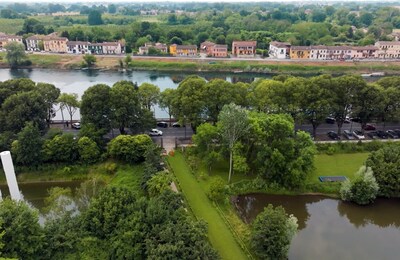MILAN, Aug. 25, 2023 /PRNewswire/ -- Urban beekeeping is experiencing rapid growth. The romantic image of bees fluttering among skyscrapers, returning nature to paved cities, is quite appealing. A recent study by Nature has shown that "we found large increases in hives numbers across all cities from an average 6.48 hives per km2 (3139 hives in total) in 2012 to an average 8.1 hives per km2 (6370 in total) in 2018 and observed that available resources are insufficient to maintain present densities of beehives, which currently are unsustainable."

Also, according to data from the United Nations Food and Agriculture Organization (FAO), between 2011 and 2021, the number of beehives worldwide grew by 26 percent, increasing from 81.4 to 101.6 million. But is urban beekeeping really the panacea we all believe it is for urban biodiversity and sustainability?
Limited Space: A Hostile Environment for Bees
Cities represent complex territories for bees. Although some green spots offer refuge, the urban environment often provides limited space and floral variety, making it challenging to sustain a significant number of hives and substantial honey yields. The lack of a wide variety of flowers and plants from which bees can gather pollen and nectar is a significant obstacle urban beekeepers face.
Competition with Wild Bees: A Threat to Biodiversity
Cities are not only home to domestic bees but also a variety of wild bees and other pollinating insects. Introducing urban hives can thus spark competition for food resources between domestic and wild bees, risking the survival of native species and reducing overall pollinator biodiversity.
In conclusion, there is an urgent need to act to regenerate biodiversity in cities. We need to work on solutions that can ensure the well-being of all pollinating insects, particularly wild ones. Urban beekeeping is not the solution and this approach goes beyond merely creating a green illusion without delivering real benefits to urban sustainability. So, what can we do in this regard? The necessity for targeted and effective measures to make our cities greener is clear, but what specific steps can we take to achieve this goal?
The Three Fundamental Actions to Restore Biodiversity in Cities
Bringing biodiversity back to cities is not just a wish but an achievable goal with a clear and measured strategy. The essential actions can be summarized in three phases, aiming to create a balance between the urban world and nature:
- Analyzing biodiversity: knowing and understanding the starting point is essential. Studying the current urban ecosystem, monitoring existing species, and identifying areas most suitable for regeneration enables an effective action plan.
- Managing greenery: greenery management policies must be resilient to extreme events, promoting a healthy and sustainable environment. This includes selecting suitable native plants, maintaining green areas, and preventing ecological imbalances.
- Developing urban biodiversity regeneration projects: avoiding the reintroduction of aggressive and competitive species such as the honeybee, with a 360-degree goal of safeguarding and protecting biodiversity, to create a flourishing and sustainable habitat for all pollinating insects.
In this context, 3Bee's Biodiversity Oases represent a pioneering initiative. They are urban and agroforestry biodiversity habitats featuring refuges for pollinators and native flora. Certified and controlled by the tech company's in-house technology, their impact is constantly measurable and supported by major research partners backing the regeneration program. To date, 3Bee has created 123 Biodiversity Oases, planted over 20,000 nectar-producing trees and supported over 5,000 biomonitoring beehives. 3Bee's goal now is to create the largest European ecological corridor for pollinators.
"Cities are fertile ground where human ingenuity and nature can work together in harmony. The role of growers is crucial in this process: they are the true cultivators of biodiversity, experts in protecting and caring for species, essential not only in rural areas but also in urban ones. Our Biodiversity Oases, guided by their skill and dedication, represent a bridge between technological progress and respect for the environment. At 3Bee, this vision is at the heart of our daily work, and we firmly believe in its potential to create a more sustainable future," says Niccolò Calandri, CEO of 3Bee.
Media Contacts: Lisa Santillo - PR & External Relations,3Bee ;lisa.santillo@3bee.com;+39 334 3524837
Photo - https://mma.prnewswire.com/media/2193790/3Bee.jpg
![]() View original content:https://www.prnewswire.co.uk/news-releases/urban-beekeeping-a-green-illusion-the-need-for-a-measured-approach-to-regenerating-biodiversity-in-cities-301909632.html
View original content:https://www.prnewswire.co.uk/news-releases/urban-beekeeping-a-green-illusion-the-need-for-a-measured-approach-to-regenerating-biodiversity-in-cities-301909632.html
 Voltar noticias em Inglês
Voltar noticias em Inglês